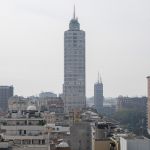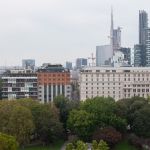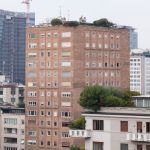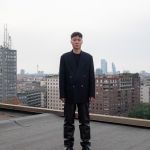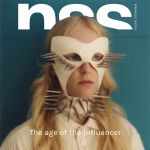
Milan is going through a peculiar moment in its history: the city seems suspended between a recent past of urban and social development of the future that was meant to continue growing despite an unprecedented present created by the pandemic.
The pace at which the city has grown has touched the limit of a burn out - there has been no special weeks, or events - also doubling is the mechanisms of the fashion industry still constrained by cycles not suitable for a bulimic trend context. The model that has guided the growth of Milan is based on the physical connection between people and spaces, between public institutions and brands. From apertivi to club life, to events, brunches and chats, Milan has based its growth on the intersection of ideas, projects and visions. At the same time, the pandemic and the lockdown have highlighted the limits of this metropolitan urban model, pushing urban planners to reimagine the balance between public and private spaces and consequently the rhythm of life in the city.
The main variables of the model are the basic components of space and time. For this reason, photographer Michele Foti took the reality of Milan’s suspension, by capturing the essence of the moment through a delicate play of lights, spaces and character. Despite the economic damage, many industries - fashion among one of them - are taking advantage of the pandemic to correct their past mistakes and distortions that the fast pace of the pre-pandemic life had crystallized. Similarly, Milan has the opportunity to seize this moment of suspension to understand where the city can start again, following the same virtuous model of intertwining ideas, industries and people that made it the city it is today.
At beginning of a new lighter lockdown, nss magazine asked a series of creative industry professionals their opinions of where and how they believe Milan can restart. Each of their opinions can be found on a map of the city below, each of which are positioned in accordance to the places from which they believe the city can restart.
Credits
Art Direction @Vincenzo Schioppa
Photography @inneromodo
Photography Assistant @Alessandro Biasotto
Visual Direction @Layuhl Jang
Styling @ElisaVoto
Styling Assistant @Fabio Princigallo
Casting @streetpeoplecasting
Grooming @Simona Parrella
Thanks to: @Skyline_Milan and @residenzalocation
Creative Direction and Production @nssfactory
MILAN INTERRUPTED - nss magazine Digital Cover N.04
After exploring the future of fashion, nss magazine looks towards attempting to forecast a future for the city of Milan
October 21st, 2020
From where and what Milan should start over?
It was the summer of 2015 in Milan, underground the metro’s linea rossa was in full force and heading to Rho Fiera, while in the city’s skyline the framework of what would become the first skyscraper of the Tre Torri of City Life was just beginning. Five years later after periods of the city's roaring growth have passed, those skyscrapers of the New Milan are finally ready and yet its offices remain for the most part empty inside. In addition to things closed shut atre the restaurants and shops hidden in the mall at the foot of the works of Arata Isozaki, Daniel Libeskind and Zaha Hadid. The scene has become vaguely dystopian, like when an architect completes the rendering of a space without projecting human figures into it.

dress: MIU MIU, boots: MARCO RAMBALDI
The City Life’s scenario is just one of many offered by Milan during the pandemic, a city that over the past twenty years has reinvented itself with an innovative model whose main feature was the physical connection between people and public institutions and brands.
In places like New York to London, the pandemic has jammed this mechanism in all the metropolises of the world, but in Milan - being the youngest and smallest of the "global cities" - the feeling is that of a city suspended between a past recent still in progress and a future suddenly so uncertain.
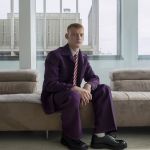
Jacket, shirt and trousers: MARCO DE VINCENZO, shoes: PRADA,
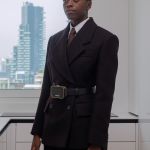
Blazer, skirt and belt: PRADA, shirt: VERSACE
The growth of contemporary Milan began chronologically more or less fifteen years ago, although thinking about it today seems a century ago. At the beginning of the millennium, Rome was the city under the spotlight occupying the front pages of the newspapers with the inauguration of the Auditorium, while Milan crafted by Craxi and the first Berlusconi was reduced to a province, whose greyness was always reflected in the public eye. The turning point began around 2004, with the second term of mayor Albertini. On one hand, Albertini was able to relaunch Milan's role as one of the world capitals of fashion and design - with the new life of fashion week and design week as we know them today - working together with private and public institutions such as the Camera della Moda, the Triennale and the Salone Internazionale del Mobile. The success and redevelopment of mainstream events have driven a whole micro universe of young independent creative realities who have exploited the pull of large institutions to make Milan their city, in a virtuous circle between mainstream and underground. At the same time, the urbanistic projects of the new Fiera and Porta Nuova were approved between Albertini and his successor Letizia Moratti, which together with the victory of Expo in 2008 were the pivotal projects that changed the skyline and the future of the city. The virtuous synergy between public, private and city has given way to projects such as the new headquarters of Fondazione Prada with the OMA project, led by Rem Koolhaas, the Pirelli Hangar Bicocca and MUDEC inaugurated in 2015 and designed by David Chipperfield.
The change in the architectural profile of the city started from the skyline and was also reflected in the streets. The large projects have served as a driving force for redeveloping - or gentrifying, depending on the perspective - entire neighborhoods: Isola, Navigli - thanks to the Darsena, a relatively cheap work due to the urban impact it had on the area -, Lambrate, Porta Venezia, Chinatown - thanks to the pedestrianization of Paolo Sarpi - and more recently the districts of NoLo and SouPra (South of Prada, to use real estate marketing slang). In the meantime, many of the neighborhoods that were populated by that "creative class" are difficult to define, but are the driving force of trends at a mainstream and underground level. Milan has become the place to observe the changes "from below" in culture: from hype to street food, passing through issues such as gender inclusiveness and sexual freedom, the city has become the Italian cultural avant-garde. Even places like Macao, which make anti-system philosophy their mantra, have become cultural centers that are accepted and respected even by institutions, creating a social humus that has simultaneously attracted Big Tech companies like Google and Facebook, fashion houses, large financial corporations, creative agencies and universities of excellence.
Shirt: GUCCI, trousers: VITELLI, tie: MAGLIANO
"At the cost of sounding cliché, Milan has managed to reinvent itself thanks to the human and creative element, and it is from here that it must start again: from the people who, by choosing Milan, making it their adoptive home, have contributed year after year to transform it from a gray and oppressive place in one of the most interesting cities in the European Union "

Underlines Chiara Nonino, photo-editor of Vogue Italia, who has seen and contributed to the change of the city that today is dealing with the problems that the pandemic has put before the metropolitan model. The absence of social events and occasions seems to have stripped Milan of the glamor that has supported the city's growth, bringing back issues that have never been resolved such as expensive rent and the suburbs. Also, that sense of coolness that cloaked Mayor Sala collapsed behind decision-making and communication errors in a time of pandemic that have awakened imaginary pandemic parochialism between the "myth of Milan" and "south working".
According to the CEO of The Attico, Stefano Marcovaldi Milano “needs to be courageous and fair in facing the challenges of the next 20 years, made even more harsh and immediate by what has happened in recent months”. Many architects - including Sir Norman Foster - are in fact convinced the pandemic will not revolutionize the way of designing a city, but rather it will accelerate some of the processes that have already been underway for years, for this reason Milan despite following the development model of global megacities , “ has the competitive advantage of being leaner and more local than other European cities, this must lead to a faster gear change than the others” according to Alessandro Poggi, Uniqlo Marketing Director in Italy.


Suit: MAGLIANO, shoes: PRADA
full look: ERMENEGILDO ZEGNA
The changes in question affect both the individual and collective spheres in city planning, according to the 2050+ architectural and research firm “one of the flaws that emerged from the pandemic is the gradual loss of the possibility of relating to the unexpected, to the unknown. For some months now, there have been fewer opportunities and less space for improvisation and random encounters. If “social distancing” seems inevitable for our post-pandemic condition, safe spaces that allow “social rapprochement” remain crucial. Milan needs more “non-codified” spaces, in which individuals can interact spontaneously, without adhering to the requirements of an already written script ”. Despite this, The lockdown has given the opportunity to rediscover some forgotten physical spaces - roofs, hallways, shared gardens - places of random sociality and sharing. On a larger scale this is the paradigm that can guide the city of the future: a model that makes uncertainty a value through the safeguarding of the neighborhood dimension, as both Francesco Chiamulera - Nike brand Manager - and Naomi Accardi - creative and journalist - , inhabitants of Isola and NoLo, have underlined.
At the macroscopic urban planning level, a fundamental role will be played in Milan by two particular themes. According to Andrea Scotti Calderini, CEO of Freeda Media "The parks were the first to be gradually repopulated after the lockdown, precisely because we all felt the need to rebuild our daily lives". In this sense, it will be essential to complete the redevelopment project of the city's railway yards, which would change the face of various neighborhoods, contributing to the transition towards ecological mobility, imagining different ways of traveling within the city. The other fundamental theme, as Emanuele Soldini, director of IED Italia pointed out, are "" decentralized places ", which are no longer peripheral. If the conventional places of attraction in the center of Milan await an increase in foreign tourists to really leave and find the usual vitality, the suburbs instead are teeming with creative everyday life."
Suit: THE ATTICO, shirt: MARCO DE VINCENZO, shoes: PRADA tie: MAGLIANO
coat: FENDI
full look: PRADA
Coat and sweater: MSGM, shirt: VERSACE, shoes: PRADA
Blazer, trousers and shoes: FENDI
The restart of Milan can go through various industries - from fashion to design - passing through gastronomy which, as Alexander Werz - CEO Karla Otto International points out," is the best representative of Milan, even in difficult times like these "but cannot ignore the awareness that the city of today and of the future will increasingly be an interconnected network, similar to the neural ones that represent the basis of new technologies. According to 2050+, which dedicates its research at the intersection of technology, environment and politics “most public investments still follow the obsolete logic of the “centric city”, which presupposes a clear hierarchical relationship between the center and the suburbs. But our condition points towards the concept of “city-archipelago”: a complex network in which different visions of society, ecology, and the meaning of citizenship meet (and sometimes collide). Milan is the unstable and ever-changing result of this continuous mediation and negotiation between conflicting interests ”.
Milan belongs to those who live it, we aim to restart it by imagining a contemporary city to this new reality.
